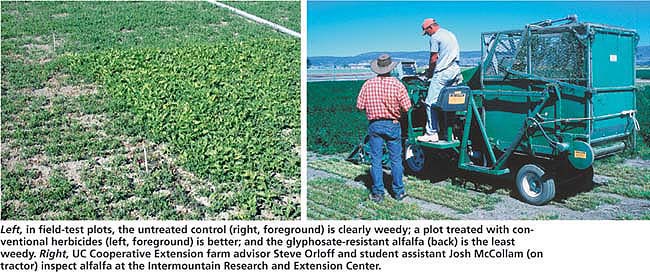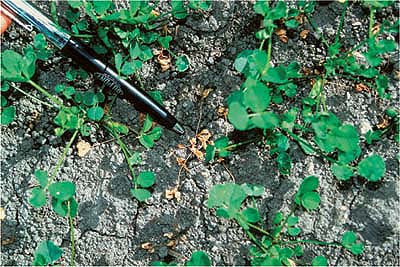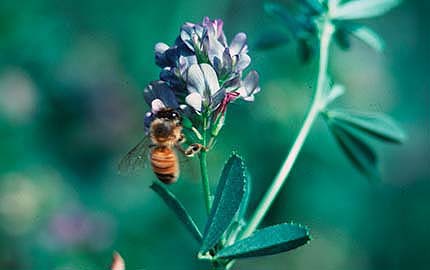All Issues
UC researchers evaluating genetically engineered alfalfa
Publication Information
California Agriculture 58(2):75-76.
Published April 01, 2004
PDF | Citation | Permissions
Full text
UC Cooperative Extension farm (UCCE) advisors and researchers are growing genetically engineered (GE) alfalfa in small experimental plots to determine whether the technology will be beneficial to California farmers.
“We would like to be ready with research-based answers when this technology is introduced,” says Steve Orloff, Siskiyou County farm advisor. “It's somewhat controversial, but providing unbiased research results will enable growers to make intelligent decisions about it for themselves.”
Although final results are not yet in, the UC scientists believe that the new varieties, which have been genetically engineered for resistance to the herbicide glyphosate (Roundup), could be an important new tool for alfalfa growers.
“It won't be a silver bullet for all farmers,” says Kurt Hembree, Fresno County weed science advisor. “Glyphosate is weak on some important alfalfa weeds, like malva, nettle, hairy fleabane and filaree. Successful weed control with this technology will depend a great deal on the ability of the growers and pest control advisers to accurately identify their specific weed problems before treating.”
Alfalfa is grown on more acres in California than any other crop and is the third most valuable crop in the United States. But because it is used primarily for dairy feed and is a few steps removed from the dinner plate, the general public does not often recognize its importance.” Alfalfa is ice cream in the making,” quips UC Davis alfalfa specialist Dan Putnam.
In anticipation of a possible 2005 commercial release of gyphosate-resistant (Roundup Ready) alfalfa, UCCE farm advisors and specialists are evaluating it in the Intermountain Region and throughout the Central Valley. “We rate the trials blind,” Orloff says. “We don't favor one approach over others.”
Left, in field-test plots, the untreated control (right, foreground) is clearly weedy; a plot treated with conventional herbicides (left, foreground) is better; and the glyphosate-resistant alfalfa (back) is the least weedy. Right, UC Cooperative Extension farm advisor Steve Orloff and student assistant Josh McCollam (on tractor) inspect alfalfa at the Intermountain Research and Extension Center.
When the herbicide glyphosate is sprayed over the top of Roundup Ready alfalfa, it kills the weeds but not the crop.
Weed control a challenge
Weed control is a major challenge for alfalfa growers. Alfalfa contaminated with too many weeds may be unpalatable to livestock and less nutritious. In California, lower-quality alfalfa hay is worth an average of about $44 per ton less than premium hay. With the Roundup Ready alfalfa plant, growers can spray glyphosate over the crop after the alfalfa and weeds have emerged, eliminating nearly all the weeds. Later herbicide sprays may be unnecessary as the alfalfa grows vigorously and shades later-emerging weeds.
Reducing pesticide use in alfalfa could provide environmental benefits. “Alfalfa growers are working closely with state agencies to prevent runoff of insecticides and herbicides into streams and rivers,” says Mick Canevari, San Joaquin County farm advisor. “This new technology may reduce the amount of pesticides that are needed to grow the crop, and thereby reduce the risk of pesticide runoff with some of our winter-applied herbicides.”
Pollinating honeybees studied
In addition to evaluating glyphosate-resistant alfalfa, UC scientists are studying the movement of pollen by honeybees used to pollinate alfalfa crops grown for seed.
“It is important to know how far honey bees and leafcutter bees will travel to pollinate alfalfa in order to produce Roundup Ready alfalfa seed with greater than 90% trait purity and to allow growers of seed of nongenetically engineered varieties to maintain their purity standards also,” says Kent Bradford, director of the UC Davis Seed Biotechnology Center.
Field studies were conducted in 2003 by UC Davis professor Larry R. Teuber and Fresno County farm advisor Shannon Mueller, along with Allen Van Deynze of the UC Davis Seed Biotechnology Center. The studies looked at gene flow, which occurs when pollen from an outside source unites with the ovule from a plant in another field and produces a viable seed. The plots were isolated by at least 6 miles from other alfalfa crops to prevent any accidental movement of pollen from the test site.
Preliminary results showed trace levels of gene flow via honeybees moving pollen from genetically engineered alfalfa beyond 1,500 feet from a marker source; the current foundation seed-isolation standard is 900 feet from a marker source.
“These studies are confirming what we have suspected for years about honeybee movement of pollen,” Teuber says. “We expect to evaluate and perhaps combine a number strategies — including isolation distances, pollinator species and blocking cultivars by type — for maintaining the genetic purity of cultivars,” Teuber says.
However, concerns remain. Canevari has seen a “weed shift” in his experimental plots in Stockton, where glyphosate-resistant alfalfa has been grown for 3 years. “When we started this study, there were four or five stinging nettle plants on this end of the field,” Canevari says. “Now you can see nettle all along the field. We're seeing more and more nettle each year.”
Another worry is the development of herbicide-resistant weeds. Certain weeds — such as ryegrass — over the years have developed resistance to glyphosate. “At this point, we already have glyphosate-resistant corn and cotton. Alfalfa is being studied and I have a project with Roundup Ready wheat. If you were to rotate between these crops, I wouldn't recommend growing Roundup Ready crops successively,” says Ron Vargas, Madera County farm advisor. “That's really setting yourself up for weed resistance.”
Financial viability unknown
The economic feasibility of growing glyphosate-resistant alfalfa has not yet been studied because Monsanto has not announced the pricing formula for the alfalfa seed. Unlike most other Roundup Ready crops, alfalfa is perennial and does not need to be reseeded each year. An annual lease on the glyphosate-resistant trait or a price premium for the seed that takes into consideration multiple years are being considered. The UC field trials should assist growers in making an economic evaluation of the technology, since comparative yields, application rates and weed-control efficacy are being studied.
UC researchers are also considering the potential market acceptance, since growers will want to know whether buyers will purchase GE alfalfa hay. Putnam says he does not expect much resistance from the dairy industry, since it has already absorbed a number of similar technologies. Most cheese, he points out, is currently made from rennin from GE microorganisms. However, he says, there might be some consumer resistance to the GE alfalfa in markets that import California hay, such as Japan.
“In my discussions with exporters, there will likely be initial resistance from the export market, since some Japanese consumers are reluctant to purchase genetically engineered foods. That will likely moderate over time and will be price dependent,” Putnam says. “Organic producers will reject the technology, as they do all herbicides. Some horse owners may also initially balk at the use of genetically engineered alfalfa, but they may also quickly realize the benefits, since a number of horses die each year from poisonous weeds that could be easily removed through this technology.”
For more information, go to: http://alfalfa.ucdavis.edu.







